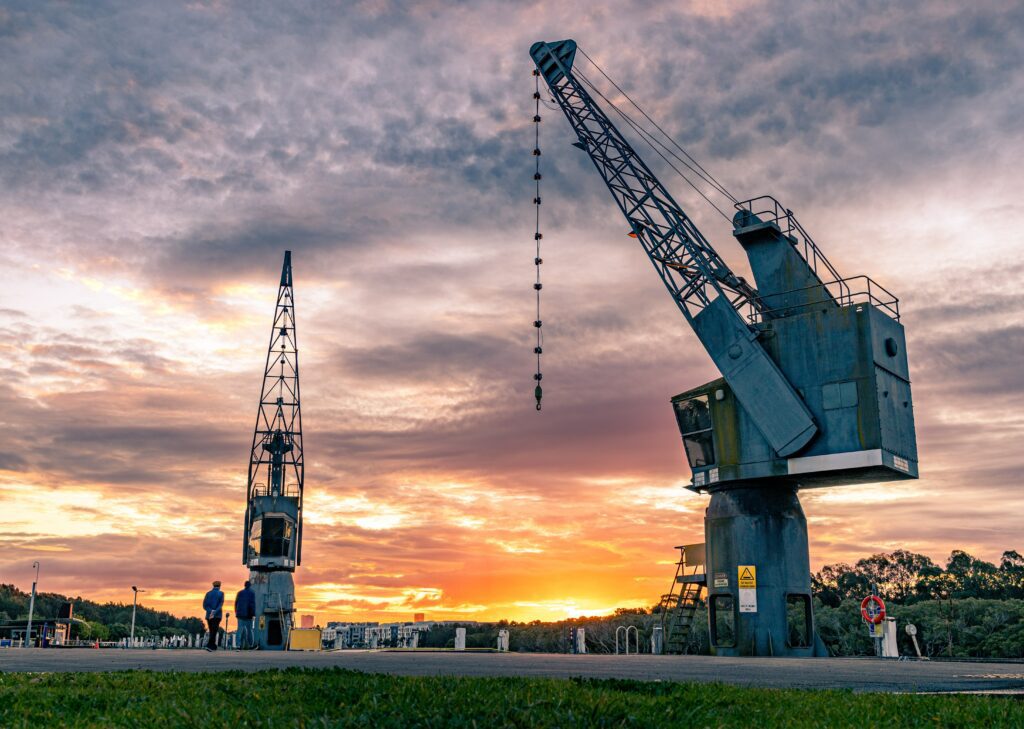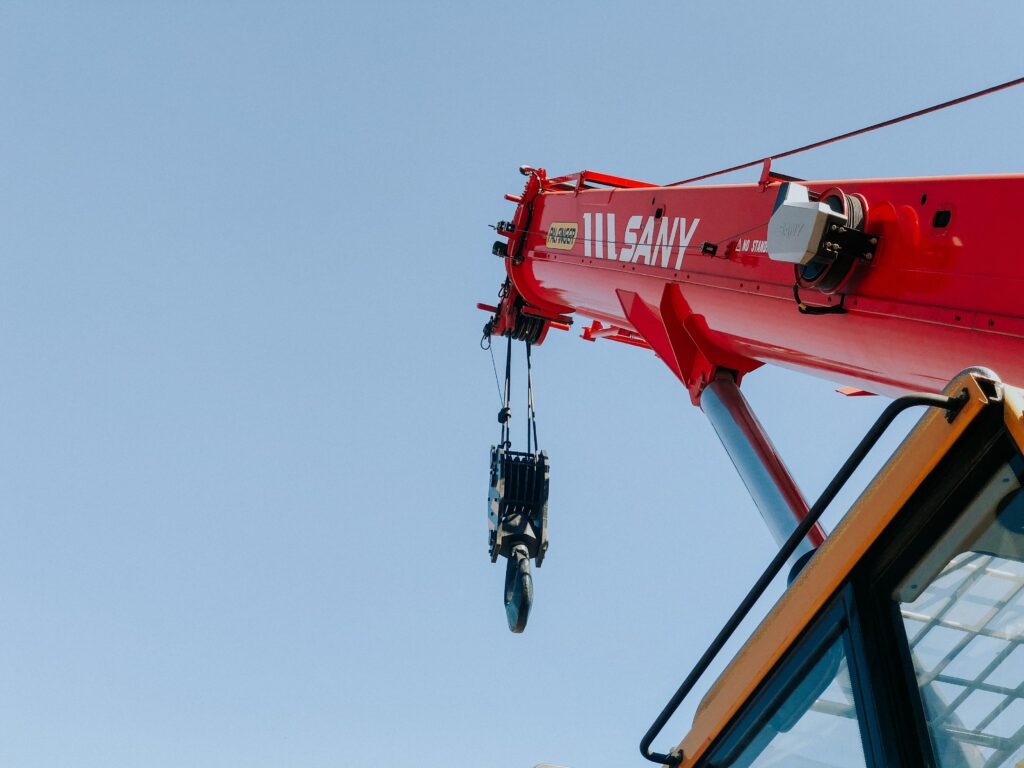Construction lifting equipments are essential to ensure efficiency and safety on construction sites. In this article, we explore their crucial role, the different types available, the associated risks, and introduce you to Happlaincourt, a provider of quality cranes. Optimize your construction sites now.
Definitions of Construction Lifting Equipments
Construction lifting equipments refer to the set of equipment used in the construction industry to lift, move, and position heavy loads. These specialized machines are designed to facilitate the transportation of materials, the assembly of structures, and the handling of equipment in a construction environment.
These equipments are equipped with powerful lifting systems and integrated safety mechanisms to ensure reliable and secure lifting operations. They are commonly used to move materials such as beams, pipes, prefabricated panels, heavy machinery, and other significant loads necessary for infrastructure construction.
Construction lifting equipments play a vital role in optimizing productivity on construction sites. Their use enables the reduction of handling time, accelerates lifting operations, and minimizes risks associated with manual handling of heavy loads. They also contribute to improving worker safety by reducing the risk of injuries caused by excessive effort or poor posture.
The Role of Construction Lifting Equipments
Construction lifting equipments play a crucial role in construction projects by facilitating the movement, positioning, and handling of heavy loads. Their use helps optimize productivity and improve safety on construction sites. Here are some key subsections to better understand their role:
Enhancing the efficiency of lifting operations
Construction lifting equipments provide increased power and precision to move heavy loads over long distances and at high elevations. This reduces handling times and speeds up construction operations, contributing to overall improved efficiency on construction sites.
Facilitating the transportation of materials
Construction lifting equipments enable the easy transportation of large and heavy materials such as beams, prefabricated panels, and construction equipment.
Structural assembly and precise installation
With their ability to lift heavy loads with precision, construction lifting equipments facilitate the assembly of complex structures, including framing elements, prefabricated components, and heavy equipment. They allow for precise alignment and quick installation, thereby accelerating the construction process.
Reducing the risks of injuries and material damages
By avoiding manual handling of heavy loads, construction lifting equipments reduce the risks of injuries for workers. Additionally, their proper use minimizes potential material damages caused by improper handling.
Managing environmental constraints
Some construction sites present environmental constraints such as limited spaces or difficult access conditions. Construction lifting equipments, with their flexibility and adaptability, overcome these constraints and enable lifting operations in complex environments.
Types of Construction Lifting Equipments
Lifting equipment comes in various types, each offering specific features tailored to different needs:
Mobile cranes
Mobile cranes are versatile and easily movable on construction sites. They offer a wide reach and high lifting capacity, making them ideal for construction projects that require frequent mobility and maximum flexibility.
Tower cranes
Tower cranes are fixed structures that provide impressive reach and high lifting capacity. They are commonly used for high-rise constructions, enabling the movement of materials on large-scale sites.
Elevating work platforms
Elevating work platforms, also known as aerial lifts, provide safe access to elevated areas. They are used for work at heights, building inspections, and accessing hard-to-reach areas.
Telescopic handlers
Telescopic handlers, also known as telehandlers or rough-terrain forklifts, combine the functionalities of a forklift and a crane. They are versatile and can lift and transport heavy loads on various terrains, offering great adaptability on construction sites.
Hoists
Hoists are used for vertical lifting of loads, primarily indoors. They are commonly employed for material transportation between different levels and provide an efficient solution for vertical handling.
By exploring the different types of construction lifting equipment, you can choose the one that best suits your specific needs in terms of lifting capacity, reach, mobility, and terrain usage. Understanding the characteristics of each type of lifting equipment is important for making informed decisions when planning your construction projects.
Risks of Construction Lifting Equipments
The use of construction lifting equipment involves certain potential risks that are crucial to consider to ensure safety on construction sites. A thorough understanding of these risks is essential for implementing appropriate safety measures. Here are some of the key risks associated with construction lifting equipment:
Firstly, there is a significant risk of load falls. This can occur due to inadequate securing or an imbalance of the load. When a load falls, it can cause serious injuries to workers present on the site. Therefore, it is essential to ensure that loads are properly secured and balanced before conducting any lifting operations.
Tip-overs are also a major concern. Lifting equipment can tip or overturn due to various reasons such as unstable terrain, improper use of equipment, or overloading. These situations can result in serious or even fatal injuries to operators and individuals in the vicinity. It is therefore essential to adhere to the maximum lifting capacities.
Collisions with other equipment, structures, or workers on the construction site are another risk to consider. Traffic and communication must be well organized on the site to minimize the risk of collisions. Clear signage, effective coordination, and constant vigilance are necessary to prevent such accidents.
Lastly, it is important to note that faulty or poorly maintained lifting equipment can lead to serious accidents. Regular inspections, proper maintenance, and appropriate repairs should be carried out to ensure that the equipment operates correctly and safely.
What Permit or Certificate is Required to Operate Construction Lifting Equipments?
Driving construction lifting equipment often requires a specific license or certificate. The legal requirements vary depending on the country and the type of equipment used. It is essential to comply with the applicable regulations and undergo proper training to obtain the required certifications.
In France, operating construction lifting equipment typically requires a specific license or certificate in accordance with the current regulations. The legal requirements vary depending on the type of equipment used and the lifting capacity. Here are some key pieces of information about the required licenses and certificates:
1. CACES (Certificat d’Aptitude à la Conduite en Sécurité)
This certificate is issued by an accredited organization and attests to the skills and knowledge required to operate certain types of lifting equipment. CACES certifications are specific to each equipment category (cranes, forklifts, aerial work platforms, etc.) and are valid for a specified period.
2. C License (Permis C)
The C license is required for driving certain vehicles equipped with cranes with a lifting capacity of more than 3.5 tons. It is issued by the relevant driving authorities and requires specific training.
3. Specific Training
Depending on the type of equipment used, specific training may be required. For example, for aerial work platforms, PEMP (Plateformes Élévatrices Mobiles de Personnes) training is necessary. This training is provided by accredited organizations and enables individuals to acquire the skills necessary for the safe operation of aerial work platforms.
It is important to note that regulations and requirements may change, so it is recommended to refer to the competent authorities and training organizations to obtain the most up-to-date and accurate information regarding the licenses and certificates required for operating construction lifting equipment in France.
Discover Happlaincourt: Your Supplier of Construction Lifting Equipments
To meet your construction lifting equipment needs, we recommend Happlaincourt. As a trusted provider, Happlaincourt offers a wide range of quick-assembly cranes from the HIT-CRANE brand, known for their reliability and exceptional lifting capabilities. Whether you require short-term or long-term rental or are interested in purchasing, Happlaincourt currently has a fleet of 6 cranes available on the market that have already proven their worth. Additionally, the prices offered are very competitive.
Conclusion
Construction lifting equipment is essential to ensure the success of your construction projects. By choosing the appropriate lifting equipment, adhering to safety standards, and receiving proper training, you can enhance the efficiency of your operations while maintaining the safety of your team. Don’t hesitate to rely on reliable suppliers like Happlaincourt to acquire the necessary equipment for your construction sites.



